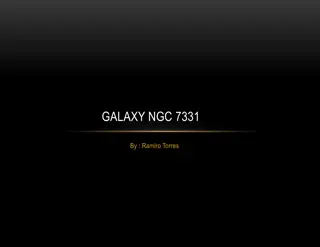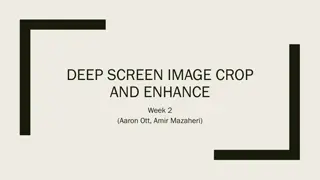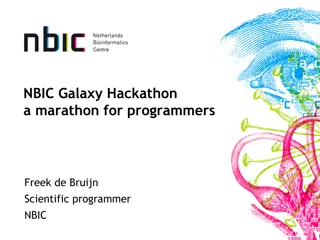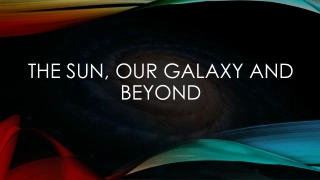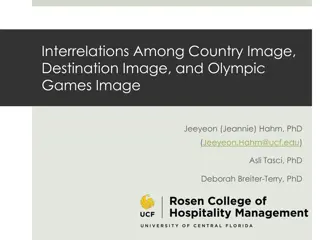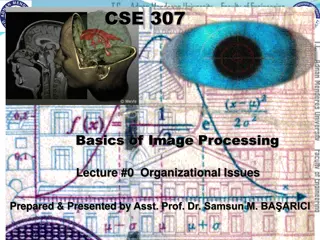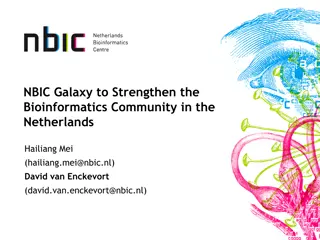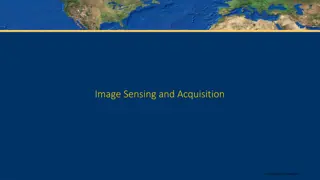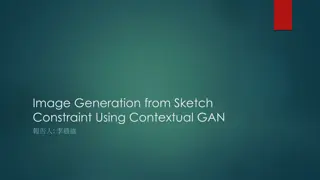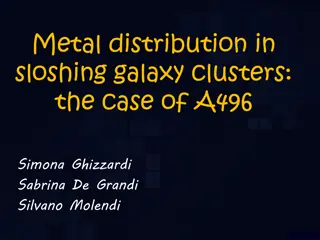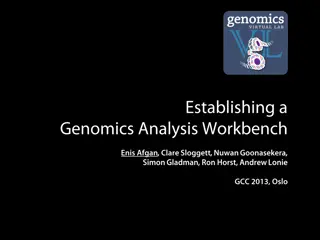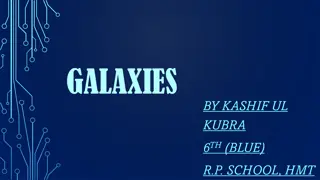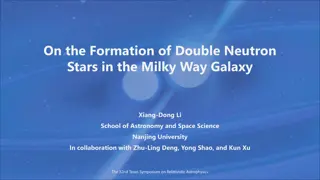Galaxy Image Analysis Methods and Tools Overview
Explore various image analysis algorithms and software tools used in astronomy for studying galaxies, stars, and other celestial objects. Learn about techniques such as Galfit, PyMorph, and more for extracting valuable information from digital images to advance scientific research in astrophysics.
Download Presentation

Please find below an Image/Link to download the presentation.
The content on the website is provided AS IS for your information and personal use only. It may not be sold, licensed, or shared on other websites without obtaining consent from the author. Download presentation by click this link. If you encounter any issues during the download, it is possible that the publisher has removed the file from their server.
E N D
Presentation Transcript
C: A: S: G: ?20: C 80% 20%
Merging galaxy (A>0.35)&(A>S) G>-0.14* ?20+0.33
Ishape S ren S. Larsen (PSF) FWHM star clusters in external galaxies BAOLab FWHM, PSF ??j (i,j) ?? ?free (x,y) a b ??,??,? FWHM. (x , y), PSF
1. 2. (?0,?0) ??? 3. ??? 4. (??,??) (?) HWFM 5. ??in (??,??,?) (a) S (??,??,?) (b) PSF M=S*P (c) M a b ???,??,? (d) ??,??,? (e) a-d ??in 6. c ? PSF ??in 7. M, W, I-M, 2 2 2 (?,?,?,b), x,y,a,b ??in ??,??,? 2 (??,??,?) 2
Gglfit Chien Y. Peng Galfit2is an image analysis algorithm that can model profiles of galaxies, stars, and other astronomical objects in digital images. If successful, the features of interest are summarized into a small set of numbers, such as size, luminosity, and profile central concentration, which one can compare against other objects for doing science ??2 ???? fdata fmodel ?(?,?)
A) B)Imgblocks.fits: C)Sigma image( D)PSF F)Bad pixel mask H)Image region to fit(Xmin,Xmax,Ymin,Ymax) I)Size of the convolution box (X,Y) J)Magnitude Zeropoint K)Plat scale: [mag/arcsec2] P)Option :0&1&2&3 0 1 2 3
Galfit Item 0 object name Item 1 2 Item 3 sersic Item 4 Item 5 n Item 9 Item 10 item 0 galfit sersic psf sky
PyMorph Vinu Vikram PyMorph is a software pipeline which computes non-parametric and parametric morphological parameters of galaxies . (1)Python 2.7 or greater not python 3.0 or greater (2)numpy (3)matplotlib (4)pyfits (5)GALFIT (6)sextractor (7)xpa(optional, if you want to select PSF) (8)MySQLdb(optional)
1.Normal mode: 2.PSF selection: To select the PSFs from image 3.Repepeat mode: he parameter estimation process can be failed dueto several reasons. If the user feels that the fitting can be improved by adjusting the initialvalues or using an efficient mask, this mode can be used. Here the pipeline will run again onthe failed galaxies using the user specified parameters and images. 4.Find and fit: generate parameters of objects which satisfy the magnitude range specified by the user.
config.py 1.Imagefile: 2.Whtfile: ( 3.sex_cata:sex 4.clus_cata: 5.Datadir: 6.Outdir: 7.Psfselect: 0=> PSF 1=> PSF 2=> PSF PSF 8.Psflist: PSF 9.Mode: 10.GALFIT_PATH:GALFIT 11.SEX_PATH:SEX 12.PYMORPH_PATH:pymorh 13.galfitv:galfit
1.gal_id: 2.ra1,ra2,ra3: RA 3.dec1,dec2,dec3: DEC 4.Z: 5.Wimg: 6.Psf:PSF 7.Ximg: X 8.Yimg: Y 9.Bxcntr: X 10.Bycntr: Y 11.C: 12.A: 13.S: 14.G: 15.?20: 11.flag
statmorph statmorph is a Python package for calculating non-parametric morphological diagnostics of galaxy images (e.g., Gini-M_{20} and CAS statistics), as well as fitting 2D S rsic profiles. The main interface between the user and the code is the source_morphology function, which calculates the morphological parameters of a set of sources
The statmorph code requires the following data: (i)image: An image containing the object(s) of interest, given as a 2D array . The code assumes that the input image is already background subtracted. (ii)segmap: The corresponding segmentation map, given as a2D array (of the same size as the image) with different integer values used to label different sources. A value of zero is reserved for the background. (iii)Weight map or gain: The weight map is a 2D array (of the same size as the image) representing the 1 variation of each pixel value, including the contribution from the sky background.12If the weight map is not provided by the user, a gain parameter must be provided instead, i.e. a multiplicative factor that converts the image units into electron counts per pixel. This is used internally by the code to estimate the weight map assuming Poisson statistics.
The following two input arguments are optional ,but their use is strongly recommended if: (iv)mask: A 2D array (of the same size as the image) with boolean values indicating the pixels that should be excluded from the calculation (e.g. pixels contaminated by foreground stars). (v)PSF: A 2D array (usually smaller than the image) representing the PSF of the observations. This is only used for the Sersic profile fitting.
For a given (background-subtracted) image and a corresponding segmentation map indicating the source(s) of interest, statmorph calculates the following morphological statistics for each source: Gini-M20 statistics Concentration, Asymmetry and Smoothness (CAS) statistics Multimode, Intensity and Deviation (MID) statistics Outer asymmetry and shape asymmetry S rsic index Several shape and size measurements associated to the above statistics
Apart from the morphological parameters, statmorph also produces two different bad measurement flags (where values of 0 and 1 indicate good and bad measurements, respectively): flag : indicates a problem with the basic morphological measurements (e.g., a discontinuous Gini segmentation map). flag_sersic : indicates if there was a problem during the Sersic profile fitting. In general, users should enforce flag == 0, while flag_sersic == 0 should be applied only when actually interested in Sersic fits (which can fail for merging galaxies and other irregular objects).



